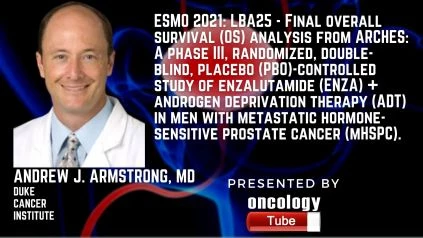Andrew J. Armstrong, MD, Professor of Medicine, Surgery, Pharmacology and Cancer Biology, Duke Cancer Institute speaks about the ESMO 2021 Abstract – LBA25 – Final overall survival (OS) analysis from ARCHES: A phase III, randomized, double-blind, placebo (PBO)-controlled study of enzalutamide (ENZA) + androgen deprivation therapy (ADT) in men with metastatic hormone-sensitive prostate cancer (mHSPC).
Abstract LBA25
Background:
ENZA + ADT, compared to PBO + ADT, decreased the risk of radiographic progression and improved secondary outcomes in males with mHSPC in the ARCHES (NCT02677896) study. The final OS (after 356 events), a significant secondary objective in ARCHES and an important benchmark of clinical effectiveness at the time of primary analysis, is shown below.
Methods:
Men with de novo or relapsed mHSPC (n=1150) were randomly assigned to ENZA (160 mg/day) Plus ADT or PBO + ADT, with disease volume and prior docetaxel usage stratified. 180 (31.3%) patients treated with PBO + ADT switched to open-label ENZA + ADT at the time of data cut-off and unblinding. Based on an O’Brien-Fleming border, a stratified log-rank test was performed with a two-sided significance threshold of 0.04 for OS. A stratified Cox proportional hazards model was used to generate hazard ratios (HRs) and Kaplan-Meier estimates of OS and time to subsequent antineoplastic treatment (TTNAnti). Treatment-emergent adverse events were used to assess safety.
Results:
The therapy arms had identical baseline characteristics. With a median follow-up of 44.6 months as of the data cut-off date of May 28, 2021, 397 (34.5%) patients were still on therapy. The median treatment duration for ENZA + ADT patients was 40.2 months, 13.8 months for PBO + ADT patients, and 23.9 months for crossover patients. ENZA + ADT improved survival compared to PBO + ADT (HR 0.66; 95 percent confidence interval 0.53, 0.81; p0.0001) [Table], with comparable results in the majority of prespecified subgroups. Compared to PBO + ADT, ENZA + ADT continued to extend TTNAnti. The ENZA + ADT vs. PBO + ADT safety profile matched the findings of the original investigation.
Conclusions:
This final study shows that ENZA + ADT significantly increases survival in men with mHSPC, and this, along with the appropriate safety profile, supports ENZA + ADT’s therapeutic value in men with mHSPC.
Clinical trial identification
NCT02677896.

